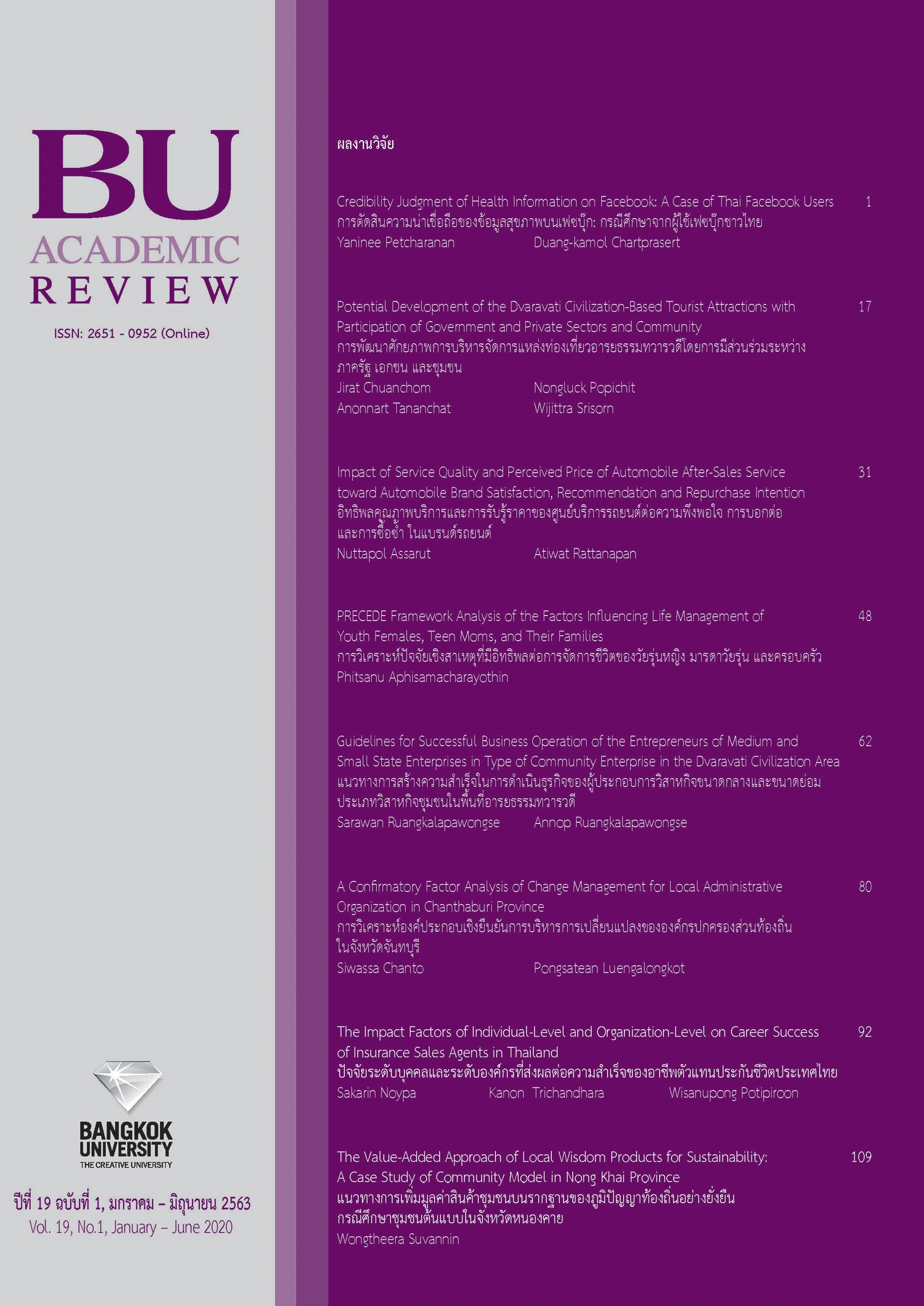การวิเคราะห์องค์ประกอบเชิงยืนยันการบริหารการเปลี่ยนแปลงขององค์กรปกครองส่วนท้องถิ่นในจังหวัดจันทบุรี
Main Article Content
บทคัดย่อ
วัตถุประสงค์ของการวิจัยครั้งนี้คือเพื่อวิเคราะห์และตรวจสอบองค์ประกอบเชิงยืนยันของการบริหารการเปลี่ยนแปลงขององค์กรปกครองส่วนท้องถิ่นในจังหวัดจันทบุรีกับข้อมูลเชิงประจักษ์ ประชากรที่ใช้ในการวิจัยครั้งนี้ คือ ผู้บริหารทุกระดับขององค์กรปกครองส่วนท้องถิ่นในจังหวัดจันทบุรี (เทศบาล และองค์การบริหารส่วนตำบล) จำนวนรวมทั้งสิ้น 754 คน กลุ่มตัวอย่างที่ใช้ในการวิจัยทั้งสิ้นมีจำนวน 400 คน เลือกตัวอย่างโดยใช้วิธีการสุ่มตัวอย่างชั้นภูมิแบบเป็นสัดส่วนจากนั้นจึงใช้วิธีสุ่มตัวอย่างอย่างง่าย ในการเก็บข้อมูลครั้งนี้ ผู้วิจัยได้สร้างแบบสอบถามสี่ระดับเพื่อเป็นเครื่องมือในการเก็บข้อมูลและมีค่าความเชื่อมั่นของแบบสอบถามทั้งฉบับเท่ากับ 0.983 วิเคราะห์ข้อมูลโดยใช้สถิติการวิเคราะห์องค์ประกอบเชิงยืนยัน ผลการวิเคราะห์และตรวจสอบพบโมเดลการวัดตัวแปรการบริหารการเปลี่ยนแปลงขององค์กรปกครองส่วนท้องถิ่นในจังหวัดจันทบุรี อันได้แก่ การกำหนดวิสัยทัศน์ของการเปลี่ยนแปลง การสร้างการมีส่วนร่วม การรักษาการเปลี่ยนแปลงให้คงอยู่เป็นส่วนหนึ่งขององค์การ และการสร้างความตระหนักถึงความสำคัญในการเปลี่ยนแปลง ตามลำดับ มีความสอดคล้องกับข้อมูลเชิงประจักษ์ พิจารณาจากค่าดัชนีความสอดคล้องกลมกลืนประกอบด้วย c2= 3.306, df = 2, c2/ df = 1.653, p-value = 0.191, TLI = 0.991, RMSEA = 0.040, SRMR = 0.013, CFI = 0.997.
Article Details
บทความที่นำมาสมัครลงตีพิมพ์ในวารสารต้องไม่เคยได้รับการตีพิมพ์เผยแพร่มาก่อน และไม่ส่งต้นฉบับบทความซ้ำซ้อนกับวารสารอื่น รวมทั้งผู้เขียนบทความต้องไม่ละเมิดหรือคัดลอกผลงานของผู้อื่น
เอกสารอ้างอิง
Brandt, M., & Sommer, P. (2013). The 4-by-10 ruler of change: A practical framework for managing change (Master’s thesis, Chalmers University of Technology).
Comrey, A. L., & Lee, H. B. (1992). A first course in factor analysis (2nd ed.). Hillsdale, NJ: Lawrence
Erlbaum Associates.
Conger, J. A., Spreitzer, G. M., & Lawler, E. E. (1999). The leader’s change handbook: An essential guide to setting direction and taking action (3th ed.). San Francisco:
Jossey- Bass.
Department of Local Administration. (2016). Information System Center of Department of Local
Administration. Retrieved December 2, 2019, from http://info.dla.go.th/public/surveyI nfo.do
Hiatt, J. M. (2006). ADKAR: A model for change in business, government and our community. Colorado: Prosci Learning Center Publication.
Hooper, D., Coughlan, J., & Mullen, M. (2008). Structural Equation Modeling: Guidelines for
determining model fit. Electronic Journal of Business Research Methods, 6(1), 53-60.
John P Kotter. (1996). Leading change. Boston: Harvard Business School.
Lippitt, R., Watson, J., & Wesley, B. (1958). The dynamics of planned change. New York:
Harcourt, Brace and World.
Loganit, W., & Luengalongkot, P. (2017). The behavior executive of the local administrative organization in Chantaburi province. FEU Academic Review Journal, 11(1), 161 – 171.
Luecke, R. (2003). Managing change and transition. Boston: Harvard Business School Press.
Luengalongkot, P. (2014). The relationship between administration with good governance
and service quality of Na Yai Arm Sub-District Administrative Organization, Na Yai Arm District, Chantaburi Province. STOU Journal, 27(1), 78 – 90.
Makumbe, W. (2016). Predictors of effective Change management. African Journal of Business Management, 10(23), 585-593.
Metre, C. (2009). Deriving value from change management. (Master’s thesis, University of
Pennsylvania).
Muthén, L. K., & Muthén, B. O. (2000). Mplus: The comprehensive modeling program for
applied researchers; user’s guide, Version 5.21. Los Angeles, CA: Muthén & Muthén.
Office of the Public Sector Development Commission. (2013). Handbook of new public
administration’s technique according to good governanceg. Bangkok: Office of the Public
Sector Development Commission.
Pinchareon, S. (2013). Leadership and management. Bangkok: Jamjuri Products.
Sala, C. (2013). Basic Knowledge for administration of local government organization. Bangkok, Chulalongkorn University.
Srihong C. (1999). Research Methodology. n. p.


